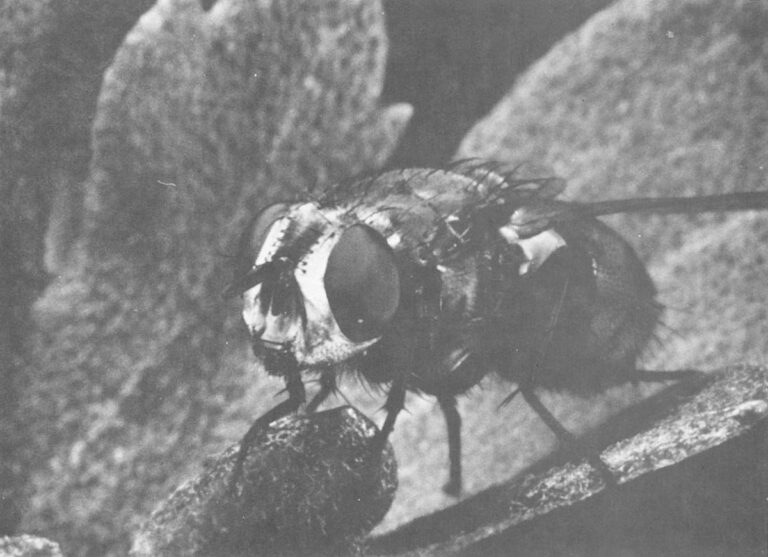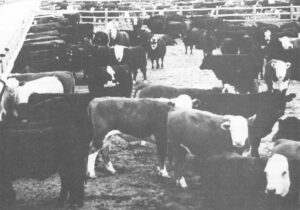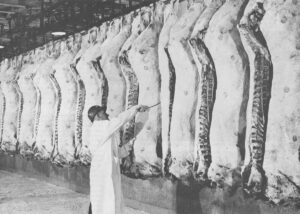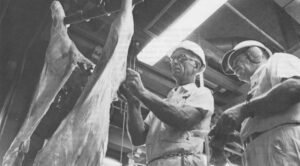(FT. MORGAN, CO) — When the insecticide salesman arrived at Fred Diehl’s Dairy in Dodge City, Kansas, it was undeniable that Fred had a problem. During the summer heat his sixty head of registered Holstein milk cows were so harrassed by flies their milk production was suffering.
After hearing the sales pitch, Fred got sold an automatic sprayer — “the whole works” as he remembers it — which when fastened to the door of the milking parlor automatically sprayed each cow with Vapona (a chlorinated organo-phosphate which acts on the nervous sysiern causing convulsions and death) as it walked out after being milked.
“You pretty near had to use something,” says Fred with resignation, leaning against the pasteurizer in the dairy he is now too weak and sick to work. “Those flies were all over the cows.” As he talks, he repeatedly rubs his pale forehead with one hand as if trying to ease some deep inner pain.
Indeed, the Vapona spray did help control the flies, and Fred’s cows did appear more comfortable. But like an unwelcome spirit exorcised from one dominion only to take up residence in another, Fred Diehl became the unwitting victim of his cows’ gain. What he had not accounted for was the prevailing wind, which came right across the prairie unopposed for several hundred miles and in through the milking parlor door. Every time the automatic sprayer was tripped, a fine mist of Vapona would gust in on Fred at the milking machines.
“The salesman told me to put it right on the door. But it should have been far away,” recounts Fred gravely. “When I started coughing, I just thought I had a cold. The doctors told me it was a bronchial condition,” he says, standing inertly in the midst of the busy dairy. “Finally, when I couldn’t stop coughing and woke up with no energy every morning, I went to a specialist in Oklahoma City. They gave me some medicine and told me they’d seen a lot of guys like me. They called it ‘farmer’s lung’.”
“Those pesticides destroyed my husband’s lungs,” offers Fred’s wife as she overhears our conversation on her way to the cooler with a case of chocolate milk. “He can’t work,” she adds with a tinge of anger, as if to let me know someone had dealt her husband a low card.
“Sent the whole thing to the dumps,” says Fred, smiling wanly, somewhat embarrassed by his wife’s public pronouncement of his condition. “When I get really bad now, I go to the hospital. They give me something in my veins so I can breathe.”

“I believe that man’s in trouble,” Steve Heising, a field representative of the Colorado Insectory had told me after he first visited Diehl’s Dairy trying to sign them up for a program of biological pest control which checks flies with predator wasps. “They’re all spraying,” he says, shaking his head. “I don’t know if it’s ignorance or resistance to other methods, but they’re all out there spraying like hell. I wouldn’t want to eat any meat or drink any milk from those dairies and feedlots. The whole concept just doesn’t suit me.”
The Colorado Insectory in Durango is based on a different concept of pest control. Its executive director is John Evans, a tall blonde man in his late twenties. Originally from a farm family in Nebraska, he majored in entomology at Gustavus Adolphus College in Minnesota before moving to Colorado to set up his new business.
“That’s our product hatching out of a fly pupa,” says Evans sitting at his booth at the Colorado Cattlemen’s Association annual convention in Greeley. Inside a glass chemist’s jar with a cork top, one can see hundreds of brown, blimp-like fly pupa — each about the size of a rice kernel. And from right up close, one can just make out a number of tiny, delicate wasps, about the size of gnats, flying around inside the jar.
Behind the fold-up card table at which Evans sits with his wife Susan are two glossy color photos showing two magnified wasps perched on the ends of fly pupae, the last stage in a fly’s life cycle before adulthood. One wasp is laying eggs which will feed off the fly pupa, killing the pupating insect inside. The other wasp is just being born from this strange sustaining womb.
“The basic idea is simple,” says John, sitting behind his table waiting for prospective clients to get out of a speech on ‘The Cowman’s Present and Future Credit Situation’. “People who raise livestock have a fly problem, and we think we have a good way to control them through these wasp parasites — spalangia endius — which stop the fly’s reproductive cycle by burrowing down into the manure where the flies develop. They either eat the fly pupae or lay their eggs in them. We use insects to kill insects.”
“Rearing beneficial insects for pest insect control” reads the motto on Evans’ name card. Indeed, it is odd to find the likes of John Evans here, surrounded by an industry which is yearly becoming more and more reliant upon drugs and chemicals in livestock production. But while Evans has an almost youthful academic look — which contrasts starkly with the cattlemen in their cowboy hats, hand-tooled boots and silver belt buckles — it is immediately apparent he is not some counter cultural crusader who has dropped in from the nether regions of coastal America to reform the cattle industry. He is a bright young businessman who understands livestock production. He is marketing an idea whose time has come.
Flies may seem a distant problem to a consumer picking steaks out of the local supermarket meat case. But to the meat producer they are an inescapable fact of life. At some feedlots flies become so numerous hired hands must turn on their windshield wipers in order to see out while driving through the pens.
Flies carry diseases like pink. They lay their eggs in the wounds of livestock, which cause the wounds to fester. They bother the animals and impede weight gain. Slower gains mean less profit or larger losses. Studies conducted by Dr. Jack Hamil at the University of Nebraska show a serious fly problem can cause a steer to gain a quarter of a pound less each day. For an average animal which gains three to four pounds a day, that is a substantial loss.
“Sure. Many lots just go out there with a chemical insecticide and spray the whole lot,” says Evans. “They do kill almost every fly. But chemicals are expensive — and guess what? The next morning it’s just the same again. A whole generation of flies have hatched out. The chemicals just knock the flies out of the air, but don’t stop the reproductive cycle and thus have no long-lasting effect. We’re not saying wasps are the total answer,” continues Evans, smiling and handing out a brochure to curious cattleman. “We think our biological controls are making the sprays more effective because people need to use them less and the flies don’t build up such resistance.”
It is late afternoon when Evans and his wife turn into the Tom Cooper Feedlots in Ft. Morgan, Colorado to deliver the start-up colonies of wasps for their new client.
They park in a dusty lot next to a small green patch of new sod which has been rolled out in front of a new office building in an apparent attempt to gussy up the entrance.
“Arch. The people are here with that wasp deal,” announces Peggy, the feedlot office manager, over her CB radio once we have entered the air-conditioned coolness inside. “We didn’t do anything for the flies here last year,” she says dispiritedly, looking out a picture window to the truck scales just outside. “Oh my God, it was something! You’d look out the window and the glass would be black. I had to spray my way out of here at night. So this year we figured we’d better do something. Maybe get a crop duster to come in with a knockdown spray like Vapona or Dibrom and do the whole place.” She gestures out the window to where 20,000 head of cattle are milling about in the heat in 25 huge pens.
Outside, John Evans is unloading several brown paper bags full of parasitized pupae from his truck when Arch Tadolini, feedlot manager, pulls into the parking area in a red four-wheel drive pickup. He is middle-aged, jovial, and appears to have already begun heralding in the weekend with a few beers, since it is late Friday afternoon.
“Even though it’s late, I’d like to show how this works,” says Evans after introductions have been made. He takes several fly pupae out of the bag and, like a jeweler holding up a precious gem to the light, he holds up one pupae between his thumb and forefinger for his client to see. Then, very painstakingly, he breaks open the miniature brown football-like shell to reveal a small, fragile wasp.
“Hey. Don’t let it bite you there, Fred,” says Arch, laughing and rearing back in mock fear of this tiny but unfamiliar insect. “Well, that’s a new one on me,” he says, wiping his red face with one hand and kicking back his cowboy hat with his other to reveal a pale line on his forehead where the sunburn stops like a water line painted on a boat.
“The best place to put these is along feed bunkers, where it stays damp around manure piles — and out wherever you may have dead calves infested with maggots,” says John, moving right along in a businesslike manner.
“And you think those little guys will eat flies?” asks Tadolini, shaking his head in disbelief, conjuring up images of these miniscule wasps devouring huge flies whole. “Well, I guess the boss says to give them a try. So, let’s go,” he adds.
“I’d like to have one of your people walk around with us this first time, to see how we distribute the parasites,” says Evans, gathering up several paper bags. “Now what you have to remember is that these wasps will take a few weeks before they show results. We have to build up their population to compete with the flies. Each adult female fly can lay up to 800 eggs at once. Under the right conditions, those eggs will grow into maggots. Then a few days later they will seek drier ground and the maggot’s outer surface will harden into a dry brown shell. This is the pupal stage that our parasite wasps will attack by laying their own eggs inside them. The baby wasp can feed off the developing fly inside.”
Out in the feedlots, it is stifling hot and dry. Feeder cattle fill the pens which are completely denuded of all vegetation. Other than the huge piles of manure which rise up in the center of each lot like brown mountains on the moon, the pens are barren. Clouds of dust-like manure blow up, sometimes forming into miniature tornadoes which sweep across the pens. One’s nostrils are soon coated with this airborne manure.
“OK. Let’s stop here,” says Evans, pausing beside a wet, convex area which is beginning to crust over in the heat. “This is the kind of place we want to hit.” Like a prospector, he kneels down to inspect a clod of manure. “Look! Look here!” he says, turning over the clod, pointing with a pencil tip to an encrustation of hundreds of tiny white grain-like particles. “Here we have some eggs which are developing into maggots. It won’t be long before they are in the pupal stage.” He sprinkles several handfuls of his product around the area. “What we are trying to do is simply augment the number of bugs which are natural fly predators,” says Evans as we walk up one of the manure hills, sending cattle scattering down the other side, creating a minor dust storm. The word ‘bug’ is a shorthand expression used by people who work at the Insectory to describe the insects they sell for pest control.
“These bugs are not exotic, imported insects. What we try to do is simply boost their numbers so they can keep pace with the prolific production rate of flies. Whereas flies can lay 800 eggs at once, at best the wasps can only lay seven or eight at once. So you see, they are at a disadvantage. But once we get a certain equality, we back off until right at the end of the season. Then we’ll step things up again for most of our customers because when the flies sense the cold weather coming, they are stimulated into a final reproductive surge. They instinctually seem to know that in order to survive the winter, they must have large numbers through the egg/maggot larval stage into the dormant pupa stage.” Evans points to a small, partially dried-up swill hole. “You see a place like that, it will breed up to 500,000 flies. In a few days it will be like Mount St. Helens spewing out ash.” He throws a handful of pupae into a crack in the drying mud, like Johnny Appleseed.
Evans walks over to the fence line and pries loose another clod of earth and manure for inspection. “There is a whole universe in one clump,” he says, turning it over and over, studying, pointing to some dried-out fly eggs that never made it and prying loose a few fly pupae which will soon hatch out. “There’s a whole manure eco-system for flies as well as their predators. Out in a place like this, when you spray too much you upset the balance so that the flies, which are extremely hardy insects and can reproduce fast, get an even greater advantage.”
We walk past a dead calf crawling with maggots. Often, pregnant heifers will unwittingly slip through preg testing and then give birth in a feedlot as they are being fattened for slaughter. The calves usually die quickly and are left in the pens to the natural forces.
“Lots which have a good deal of manure, mud, some dead animals and feed leaking out under the bunkers are not only an optimal environment for cattle, but also for flies,” says Evans, gesturing towards the putrifying calf. “So, in effect, you end up ranching flies as well as cows.”
By now, the sun — although still blazing hot — has worked its way down near the horizon. We sprinkle the last pen, and walk down one of the alleys which run through this vast bovine factory towards the office.
“We’re not entirely against sprays,” says Evans, as if to re-emphasize that for flies — like so many other insect pests — there is no miracle cure. “They have their place, but you have to be careful, particularly if you’re using bugs. A good chemical spray will kill a wasp if it hits it, because a wasp is not as hardy as a fly. But they do have a number of things in their favor. For one, they burrow down into the manure where the pupae are. Sprays don’t reach down there. Secondly, they tend to be nocturnal, which means they do most of their activity when the lots are not being sprayed. Finally, unlike flies, they don’t hang out around the cattle where most of the spraying is done. So they have a certain amount of protection from insecticides. What we are really trying to do is make sure people are aware there are alternatives, and help them see that chemicals are not the only answer.”
©1980 Orville Schell
Orville Schell is investigating the “Reliance on Drugs and Chemicals in the U.S. Meat Industry.”






